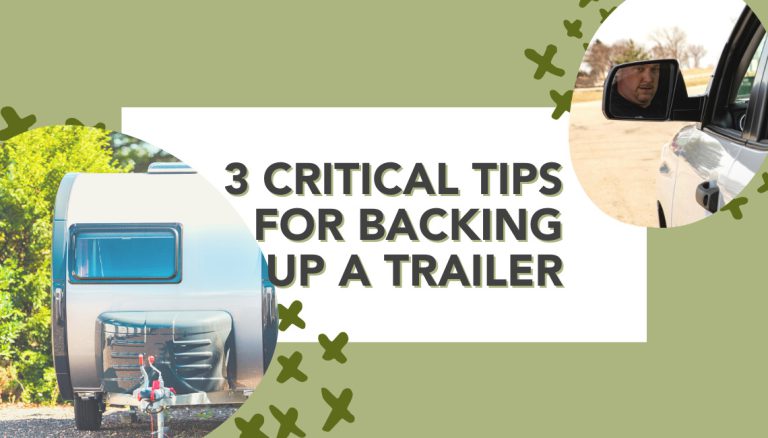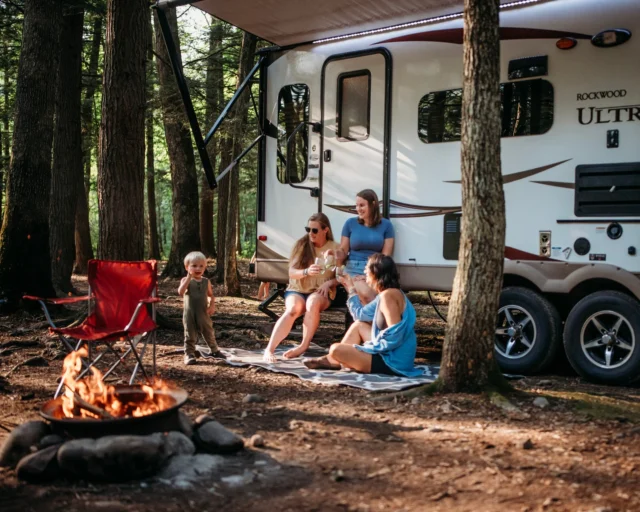

 Travel trailers offer a level of flexibility and affordability that motorhomes simply can’t match. When you’re driving a trailer, you don’t have to worry about whether or not you’ll have auxiliary transportation, as you’ll always have the vehicle you’re using to tow the trailer in the first place.
Travel trailers offer a level of flexibility and affordability that motorhomes simply can’t match. When you’re driving a trailer, you don’t have to worry about whether or not you’ll have auxiliary transportation, as you’ll always have the vehicle you’re using to tow the trailer in the first place.
But there is one part of travel trailer life that gives some campers pause — and that’s trailer backing. Backing up a trailer is an important part of traveling in one, especially since in many campgrounds only back-in sites are available. But it’s also definitely a learned skill, and there is a learning curve.
Fortunately, with a little bit of practice, you can learn how to backup a travel trailer and become a certified pro. It’s all about learning the basics before you even get started, and then making time to practice to perfection.
Here are our best tips for backing up a trailer, whether it’s a tiny Casita or a huge fifth wheel.
How to Back Up a Trailer
Backing up a trailer, ideally, starts far before you’re actually behind the wheel of your tow vehicle.
1. Study the basics.

The first thing to know about backing up a trailer is the fact that it’s all about geometry — and you can learn to understand how that geometry works before you ever get behind the wheel.
That said, the physics of it are counterintuitive. You basically want to turn your wheel the opposite way you want the trailer to go. Thus, if you turn the wheel left, the trailer will go right; if you turn the wheel right, the trailer will go left.
Once you have the trailer going in the direction you want, however, you’ll need to correct to the other direction in order to avoid the trailer jack knifing. This occurs as the rear end of the tow vehicle grows closer to the front end of the trailer and is exacerbated by the sharpness of how your wheel has been turned.
Although you’ll certainly need some hands-on practice in order to perfect the art of trailer backing, understanding these concepts ahead of time will give you a great leg up in becoming an expert trailer backer.
How do I learn to back up a trailer?
Once you’ve got the basics down, here’s the next step toward becoming less intimidated by backing in.
2. Take it slow.

Although it can be tempting to get the job done as quickly as possible, “fast” is about the last thing you want to be when backing in a trailer. In order to ensure your trailer backing experience is smooth — and that you get as much time as possible to learn what you’re doing — you’re going to want to take the process nice and slow.
You should also anticipate the fact that you’re almost certainly going to be bad at this at first; the physics are truly counterintuitive and it’s a skill that takes a while to learn. Remain calm, give yourself ample time, and if you can, try to practice before you’re actually arriving at your campsite.
Another good idea is to have a guide outside of the trailer to assist you, at least at first. This will at least ensure you don’t physically run into anything while you’re backing up. If things get overwhelming, simply stop and take a break for a few quiet minutes. You may be surprised at how much a break can help you get back on track.
3. Practice makes perfect.
When you first start learning to back up a trailer, you may feel like the entire endeavor is impossible — which is okay, and makes sense. It’s a really tough skill to learn.
But like any other difficult thing, the best way to get better at trailer backing is to do it again and again and again.
Ideally, you want to practice your trailer backing skills in a no-pressure situation — i.e., not when you’re just getting ready to park your rig for an exciting camping vacation. We recommend taking your trailer to a large parking lot and learning by feel exactly how it behaves depending on how you turn your wheel.
Of course, that homework assignment is considerably more difficult if you don’t already own a trailer. In that case, we have a few recommendations for alternative options:
- Consider playing with a toy truck, which also has a break in the middle like your trailer, to see how it behaves while backing. A little funny, we know… but it will actually help you understand the mechanics better, and it’s fun to boot!
- If that seems a little bit too childish, you could also boot up a truck simulator game, which will give you the virtual experience of truck driving. Euro Truck Simulator 2 is a good one.
- If you’re willing to go to a little bit of expense to get good at this critical camping skill, you can always rent a towable RV on the peer-to-peer market at RVshare. Simply enter your preferred dates and zip code and then filter for towable rigs. You can use the project as a great excuse to take a few more vacations!
How do you back up a trailer in a driveway?
Backing up a trailer into a driveway is essentially the same as backing it up into any other spot, except that your goal is a little bit narrower. You don’t want to hit any of the trees, vehicles, or other obstacles that may be in your way.
But like any other backing project, it all comes down to a little bit of finagling. You’ll pull forward out of and perpendicular to the driveway spot, then begin to turn the opposite directly in order to get the trailer to move backwards into it as you reverse.
Of course, you’ll also need to correct and turn the other way after a while, in order to keep the trailer from jack-knifing and also to maintain a straight back-in. Over the course of the entire backup, your wheel moves in kind of an “S” shape, or curve. It looks a bit like a “swoop.”

How do you back up a trailer into a tight spot?
Just like a driveway, you will encounter other tight spots along your trailer backing journey which will require you to make a lot of subtle adjustments as you back in. These may be tight back-in campsites, storage areas or a friend’s driveway, and in order to utilize these spots, you may need additional assistance.

One option we haven’t discussed yet — but which can make a big difference — is backup cameras. Many modern RVs come with backup cameras pre-installed, and if not, it’s easy to find an aftermarket kit to add to your setup. Backup cameras can be a major help when you’re backing your trailer, since they allow you to actually see what’s going on behind you. Of course, that won’t change the skill level it takes to actually finagle the trailer into the spot, which will still require counter-steering, stopping, correcting, and possibly even pulling forward and starting all over again. But it is nice to at least know you’re not literally about to run into something!
The best backup cameras come with lights and even infrared options for night vision, and many cost less than $500 after installation. It’s definitely an additional expense, but it may be a worthy one if you own your own trailer and back up often.
Our other suggestion for any seriously tricky back-in spots is to utilize a guide. If you don’t travel with a buddy, you can usually ask somebody at the campground or storage site for help, and it can mean the difference between a successful back-in and an accident.
How to Back Up a Small Trailer
Although small trailers back up in the same basic manner as their larger cousins, their smaller wheel base means that the turns are much tighter, so you’ll have to overcorrect more quickly. In fact, contrary to popular belief, small trailers are actually more difficult to back than larger ones!
When backing up a small trailer, keep this reduced wheel radius in mind and prepare to move your steering wheel back and forth multiple times throughout the operation. You’ll likely need to make lots of microcorrections along the way, so take heart, maintain your cool, and don’t get frustrated.
How to Backup a Trailer Using Mirrors
Mirrors are a huge part of backing up a trailer; your side rear-view mirrors can help you see where the trailer is going in response to how you move your wheel. They’re also the way you’ll be able to check to ensure you’re not about to hit anything, unless you do have a guide or backup camera.
That said, mirrors are limited in their ability to show you the whole of what’s going on; many make objects appear further away than they really are and they only have so much range. It’s important to actually, physically turn around and observe what’s going on behind you, looking out the window and ideally communicating with the guide or other people around you.
Although trailer backing can seem like an impossible feat at first, we know you’ll learn to master this important camping skill.
Better yet, it’s a great opportunity to have some fun and take a few extra vacations along the way. Enjoy the process of becoming a trailer backing pro!
This post may contain affiliate links.






